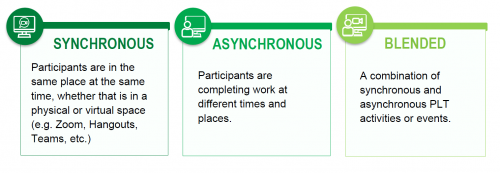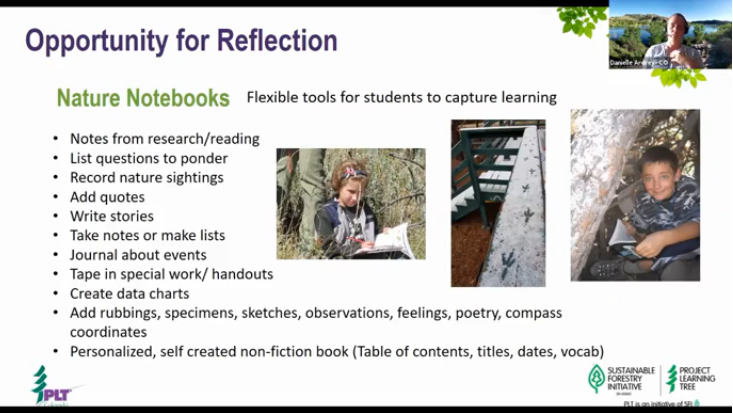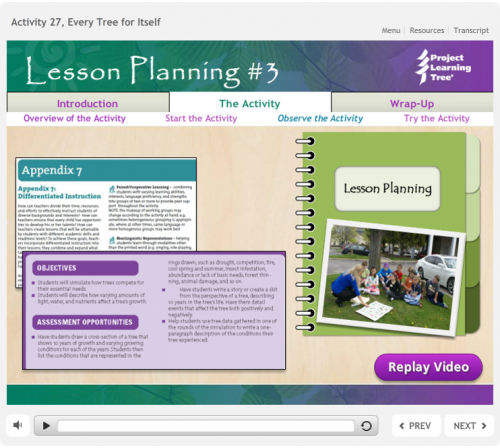September 2, 2020
The start of the 2020-2021 school year is like no other. Educators, administrators, and parents are figuring out how to provide some combination of virtual and in-person learning experiences for students. To further complicate the plans, what happens this fall may change completely as the year progresses.
We at PLT, like all of you, had to pivot quickly to this new reality last March. Typically, approximately 15,000 educators attend 800 in-person PLT professional development events organized by PLT state programs around the country. Now most PLT state programs are offering professional development that combines safe, flexible online learning with the personal experience that has been the hallmark of PLT for decades.
If you have never taken a PLT workshop or haven’t attended one in a while, this might be a great time to dig in! You’ll experience PLT activities in the virtual environment that you can then adapt to your teaching for the coming year. You will find that PLT can be a great addition to a variety of subjects, and in a variety of settings!
PLT can help you make the most of many challenges arising from the global pandemic. For example:
- The challenge: Students are each in their own home, rather than together in a classroom.
The opportunity: PLT activities offers a way for students to make the most of their different spaces, through activities such as comparing and contrasting their different environments.
- The challenge: Students are spending many hours in front of computers.
The opportunity: PLT offers a way to incorporate outdoors experiences and to learn and practice 21st digital skills as part of STEM preparation, through such activities as analyzing and visualizing data.
- The challenge: For schools holding in-person learning, CDC guidelines suggest using outdoor spaces as a way to facilitate social distancing.
The opportunity: PLT offers a way to structure outdoor learning across the curriculum and make the schoolyard a classroom.
Leveraging the Virtual Environment

Over the past few years, PLT developed six online workshops for early childhood, elementary, and middle school educators. These self-guided online courses were originally designed as stand-alone professional development. They are asynchronous training, wherein participants go through the series of short segments that make up an online course on their own schedule and pace. For those unable to attend an in-person workshop, online PLT professional development has been a great option since we introduced it, after rigorous testing, in 2015. However, some participants miss out on some of the advantages of synchronous, in-person professional development: that is, the community-building and social learning that results from interacting in real-time with facilitators and fellow participants.
PLT state programs are now offering a new modality of remote professional development—customized professional development that is both synchronous and asynchronous—blending the social learning that happens in live events with the flexibility offered by self-guided online courses.
Together Apart
Is there a better way to learn how to teach remotely than to experience it for yourself? PLT now offers remote professional development to model new ways educators can work with students virtually, including adaptations to PLT activities.
As Laura Downey, the Kansas PLT coordinator who also has a doctorate in curriculum and instruction, notes, “The initial intent in the spring was just to provide professional development in a way that was engaging and allowed for some interaction. We have been figuring out ways for people to feel they are part of a learning community, the hallmark and trademark of PLT. An added benefit is that our workshops can serve as a model to educators about how to teach high-quality environmental education to students virtually. PLT offers something so much more engaging for students than just watching something on a screen and then writing something down.”
In addition to Laura, several other state PLT coordinators recently shared new ways they are supporting educators virtually. They have created variations of PLT professional development in which participants meet live as a cohort via Zoom or other video conferencing platform, complete the online course on their own within a few weeks, then reconnect. They have found that participants value both the chance to connect with others and the flexibility of being able to do much of the training on their own schedules and not having to travel to attend a workshop. As Laura reminded me, “Who doesn’t need flexibility these days?”
A few different flavors:
- 3 live sessions + self-guided professional development + outdoor activities. Colorado PLT holds three 2-hour Zoom sessions, coordinator Danielle Ardrey explained, with the self-guided online professional development between the sessions. One advantage of these periodic contacts, she said, is that participants have the time to experience some PLT activities together during the Zoom sessions, using the chat and small group breakouts. On their own, they do several outside PLT nature activities and come together to discuss how they can use them with their students. The format has also allowed for the inclusion of guest speakers who recount how PLT has affected their own environmental career paths.

- 1 live session + self-guided professional development + online resources. South Carolina PLT had six professional development events scheduled for pre-service teachers when things shut down in March. By May, after some experimentation, they developed a new virtual model that incorporated video conferencing. According to coordinator Matt Schnabel, participants receive an introductory email to cover the administrative and technical details, as well as a heads-up about an icebreaker that will be conducted during the live session. That live, synchronous session introduces participants to the PLT program, two activities, online resources, and gets everyone on the same page about how they may use PLT in their teaching, Matt said. Participants are then given access to the online course, with about two weeks to go through it. At the end, in addition to a certificate and continuing education credit, they receive a letter with instructions on how to access the PLT curriculum electronically, how to stay connected to their local PLT network, and suggestions for other EE resources and organizations in South Carolina.

- 2 live sessions + self-guided professional development + lesson planning. In between Colorado’s three live sessions and South Carolina’s one, Virginia PLT has developed a model with two such sessions. Virginia PLT coordinator Page Hutchinson had also not done any virtual training beforehand, but quickly adapted. In addition to completing the online course, Page has participants find two or more additional activities that support their curriculum. Because Virginia has its own science standards, she has them complete Index 7, the Lesson Planning Worksheet found in PLT’s PreK-8 Environmental Education Activity Guide, making sure to correlate the activities to the Virginia Standards of Learning. Participants go into breakout groups by grade level to share and discuss the activities they’ve found, which Page said has proven very useful.

As a guiding principle for planning online teaching, Laura said, “When you use technology, it shouldn’t just be to replicate something that you can do face to face. It should take advantage of the technology and use the technology to enhance learning.” An example that she is incorporating into workshops in Kansas involves asking participants to download a magnifying microscope app on their phones. They go outdoors to study a piece of their own environment in a whole new way, take photographs, and reflect on what they have seen.
Looking Ahead
If there is a silver lining to the pandemic, it may be that we all have been pushed beyond our comfort zones and have learned new ways to do things, oftentimes with positive results.
Some state coordinators are planning to continue aspects of their pandemic-related changes even when in-person professional development events are safe again. Virtual training can help meet the needs of those who can’t attend in-person events—educators who live in more remote areas or whose schedules preclude attending evening or weekend workshops, for example. In addition, this remote professional development format can also support participants in developing a whole new set of skills, such as remote teaching. It also creates opportunities for more professional development, helping educators continually improve their teaching practices and consequentially, student achievement.
If you decide to participate in an upcoming blended professional development event that combines live sessions and self-guided courses, our Project Learning Tree coordinators offer these suggestions:
- Get the details out of the way first. If you are unfamiliar with the online platform (whether Zoom, WebEx, or others), ask for help beforehand so you are ready to roll. You can also take a quick look at the PLT website if you are unfamiliar with it to get an overview of its resources.
- Come with an open mind. PLT’s hands-on, participatory workshops are never typical professional development experiences, and these virtual sessions are not even typical for PLT. But given the completion rates and feedback to date, they are a great option.
- Evaluate the experience. This is a work in progress and your feedback about what worked and what didn’t will ensure a better PLT experience for all.
Find out what your state has planned, connect with your local coordinator for tips and upcoming opportunities, and best of luck as the school year begins!


